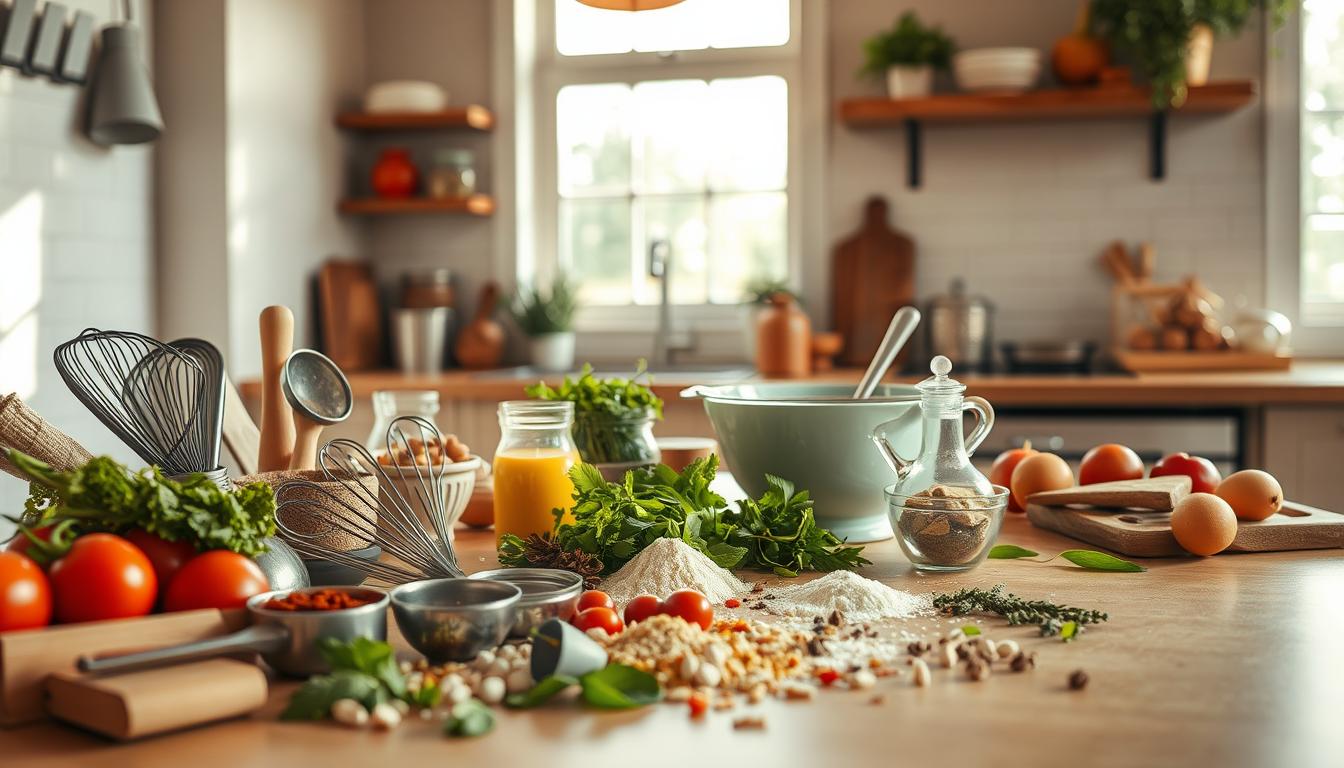Are you tired of relying on takeout and wondering if cooking is a skill reserved for the culinary elite? Cooking is a valuable life skill that can be achieved with curiosity, patience, and a willingness to experiment.
Learning to cook can be a rewarding experience, allowing you to create delicious meals and connect with others. As a beginner, it’s essential to start with the basics and build your way up. With the right guidance, you can make cooking easy and enjoyable.
Key Takeaways
- Understand the basics of cooking techniques
- Learn essential kitchen tools and ingredients
- Discover simple recipes to get you started
- Develop kitchen safety habits
- Explore different cuisines and flavors
Understanding the Basics of Cooking
The foundation of cooking lies in its basic principles and techniques. Mastering these fundamentals is crucial for anyone looking to improve their cooking skills, whether you’re a complete novice or looking to refine your existing abilities.
Fresh ingredients play a vital role in cooking. Not only do they enhance the flavor of your dishes, but they also provide better nutritional value. When shopping for ingredients, look for produce that is in season and has minimal processing. For example, choosing fresh vegetables over frozen or canned varieties can significantly impact the taste and nutritional content of your meals.
The Importance of Fresh Ingredients
Using fresh ingredients is one of the easiest cooking tips that can elevate your cooking. Fresh herbs, for instance, add more flavor than dried ones, and fresh vegetables retain more nutrients than their processed counterparts. When possible, opt for organic produce to minimize exposure to pesticides.
Cooking Terminology for Beginners
Understanding basic cooking terminology is essential for following recipes and applying simple cooking techniques. Terms like “sauté,” “roast,” and “boil” are fundamental. Familiarizing yourself with these terms will make cooking more accessible and enjoyable, providing you with valuable beginner cooking tips to get started.
By grasping these basics, you’ll be well on your way to becoming a confident cook, ready to explore more complex recipes and techniques.
Essential Kitchen Tools You’ll Need
Equipping your kitchen with the right tools is a crucial step in becoming a confident home cook. Having the right equipment not only makes cooking easier but also more enjoyable. In this section, we’ll explore the must-have utensils and cookware that every home cook should have.
Must-Have Utensils for Every Home Cook
Every home cook should have a set of basic utensils that can be used for a variety of cooking tasks. These include a good set of knives, a cutting board, measuring cups and spoons, wooden spoons, and a spatula. For more information on kitchen utensils, you can visit The Kitchn, a reputable culinary website that offers a wealth of information on kitchen essentials.
Key Utensils:
- A chef’s knife for chopping ingredients
- A paring knife for peeling and coring fruit and vegetables
- A serrated knife for slicing bread
- A cutting board for preparing ingredients
- Measuring cups and spoons for accurate measurements
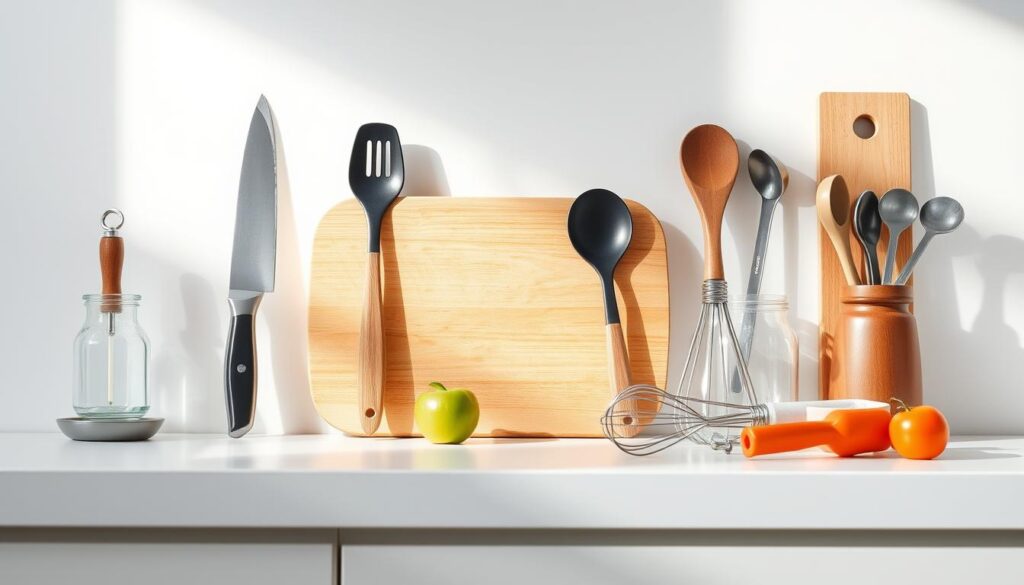
Choosing the Right Cookware
Cookware is another essential aspect of your kitchen. The right pots and pans can make a significant difference in your cooking results. When choosing cookware, consider the material, size, and heat distribution. Stainless steel, cast iron, and non-stick coatings are popular options, each with its own advantages.
Cookware Essentials:
| Type | Material | Use |
|---|---|---|
| Frying Pan | Non-stick | Ideal for cooking delicate foods like eggs and pancakes |
| Saucepan | Stainless Steel | Perfect for heating sauces and cooking pasta |
| Dutch Oven | Cast Iron | Great for slow cooking, braising, and roasting |
By investing in these essential kitchen tools, you’ll be well on your way to creating delicious meals with confidence. For more tips on kitchen essentials and cooking techniques, check out Epicurious, a trusted source for culinary advice.
Meal Planning101
Simplifying your cooking process starts with a thoughtful meal plan. Meal planning involves creating a weekly menu, shopping for ingredients, and prepping meals in advance. It’s a straightforward approach to saving time and ensuring balanced meals.
Tips for Planning Balanced Meals
To plan balanced meals, consider the following tips:
- Include a variety of food groups in your meals.
- Plan around what’s in season to ensure freshness.
- Consider dietary restrictions and preferences.
How to Create a Weekly Menu
Creating a weekly menu can be simplified by following a few key steps. First, identify your simple cooking techniques and beginner-friendly recipes. Then, plan your meals around these techniques and recipes. For more detailed guidance, you can refer to resources like meal prep guides.
Here’s an example of what a weekly meal plan might look like:
| Day | Breakfast | Lunch | Dinner |
|---|---|---|---|
| Mon | Overnight oats | Grilled chicken salad | Baked salmon with vegetables |
| Tue | Scrambled eggs | Turkey wrap | Chicken stir-fry |
| Wed | Yogurt parfait | Quinoa salad | Beef tacos |
“Meal planning allows you to cook with confidence, knowing you have a plan in place.” –
By following these steps and tips, you can create an effective meal plan that simplifies your cooking routine and ensures you’re enjoying balanced, home-cooked meals.
Mastering Basic Cooking Techniques
Embracing simple yet effective cooking methods is key to unlocking a world of flavors and recipes. For beginners, understanding the basics of cooking techniques can significantly enhance their culinary journey.
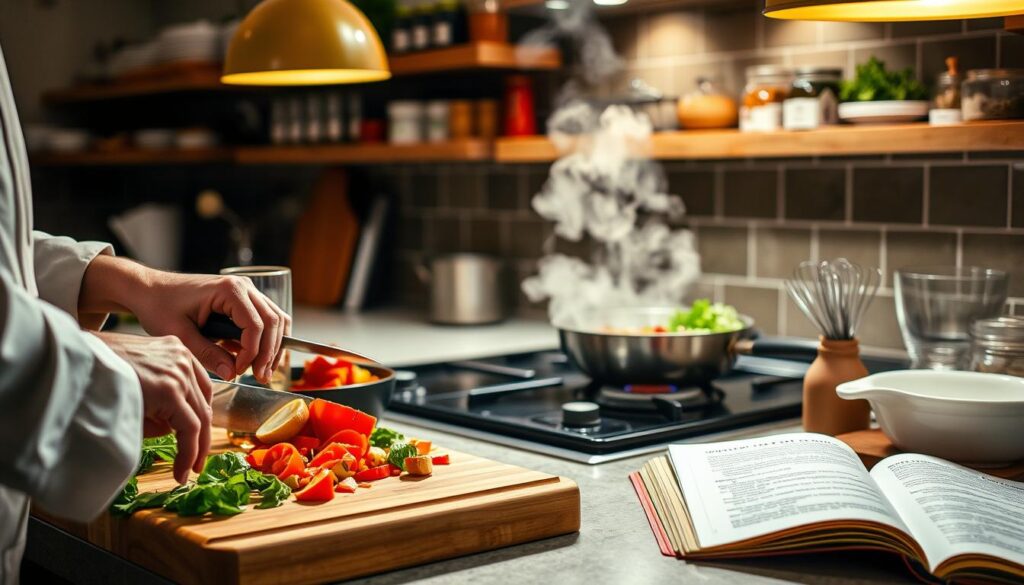
Boiling, Sautéing, and Roasting Explained
Let’s dive into some fundamental cooking techniques that every beginner should know. Boiling is a straightforward method that involves submerging food in boiling water until it’s cooked through. It’s ideal for cooking pasta, vegetables, and potatoes.
Sautéing involves quickly cooking food in a pan with a small amount of oil or fat. This method is perfect for cooking delicate foods like fish, herbs, and vegetables, preserving their texture and flavor.
Roasting brings out the best in many ingredients by cooking them in the oven with dry heat. It’s a great way to prepare meats, root vegetables, and Brussels sprouts, resulting in a caramelized exterior and a tender interior.
- Boiling: Perfect for pasta, vegetables, and potatoes.
- Sautéing: Ideal for delicate foods like fish and herbs.
- Roasting: Great for meats and root vegetables.
Introducing Baking Essentials
Baking is another essential skill for beginners to master. It involves cooking food using dry heat, typically in an oven. Baking is not just limited to sweet treats; it’s also used for bread, casseroles, and roasted vegetables.
To get started with baking, it’s crucial to understand the importance of measurements and ingredient ratios. Unlike other cooking methods, baking is more precise, so following a recipe accurately is key to success.
Some basic baking essentials include:
- Understanding your oven’s temperature and calibration.
- Using quality ingredients and measuring them accurately.
- Not overmixing batter or dough.
By mastering these basic cooking techniques, beginners can build a solid foundation for their culinary adventures, making cooking more enjoyable and less intimidating.
Time-Saving Cooking Hacks
Simplifying meal prep is easier than you think with some smart cooking strategies. Busy home cooks can benefit greatly from techniques that save time without sacrificing flavor or nutrition. In this section, we’ll explore some effective cooking hacks that make mealtime a breeze.
One-Pot Meals for Busy Schedules
One-pot meals are a lifesaver for those with busy schedules. They allow you to cook a complete meal in a single pot, reducing cleanup and cooking time. Some popular one-pot dishes include:
- Pasta Primavera: A colorful mix of pasta, vegetables, and herbs cooked together in one pot.
- Chicken and Rice: A simple, satisfying dish that’s perfect for a quick weeknight dinner.
- Lentil Soup: A hearty, nutritious option that’s packed with protein and fiber.
For more one-pot meal ideas, check out our article on delicious and easy one-pot recipes.
Prepping Ingredients in Advance
Prepping ingredients ahead of time can significantly streamline your cooking process. By chopping vegetables, marinating meats, and measuring out spices in advance, you can save valuable time during meal preparation. Here are some tips for effective ingredient prep:
- Chop vegetables for the week and store them in airtight containers in the refrigerator.
- Marinate proteins like chicken, beef, or tofu to enhance flavor and tenderize them.
- Measure out spices and seasonings for each recipe to make cooking faster and more efficient.
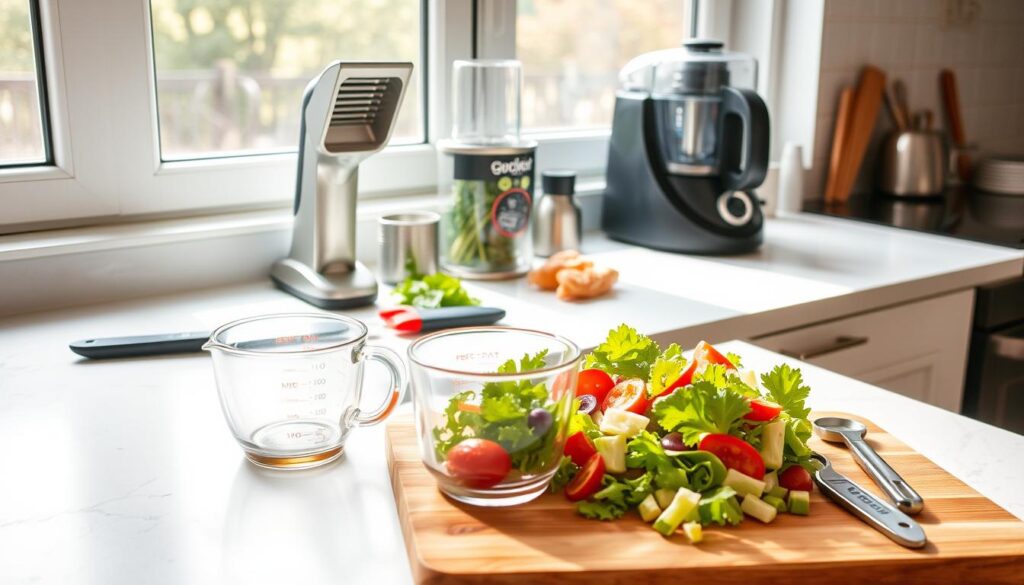
By incorporating these time-saving cooking hacks into your routine, you’ll be able to prepare healthy, delicious meals even on the busiest days. For more cooking tips and recipes, visit our blog on cooking tips for beginners.
Flavoring Your Dishes Like a Pro
Flavoring your dishes is an art that can be mastered with a few simple techniques and ingredients. Understanding how to use herbs, spices, and simple sauces can elevate your cooking and add depth to your meals.
Understanding Herbs and Spices
Herbs and spices are the backbone of any cuisine, providing the flavors that define a dish. Fresh or dried herbs like basil, rosemary, and thyme can add a bright, fresh flavor, while spices like cumin, paprika, and turmeric offer warmth and depth. The key is to experiment with different combinations to find what works best for you.
For beginners, it’s essential to start with the basics. Common herbs like parsley, cilantro, and dill are versatile and can be used in a variety of dishes, from soups to salads. Spices like garlic powder, onion powder, and black pepper are also staples that can enhance many recipes.
| Herb/Spice | Common Use | Flavor Profile |
|---|---|---|
| Basil | Pesto, Italian dishes | Sweet, aromatic |
| Cumin | Mexican, Indian dishes | Warm, earthy |
| Thyme | Soups, stews, roasted meats | Minny, slightly lemony |
Simple Sauces to Enhance Any Meal
Sauces can transform a simple dish into something extraordinary. Basic sauces like marinara, alfredo, and salsa can be made with a few ingredients and used to add flavor to pasta, meats, and vegetables.
One of the easiest ways to start is by making a simple marinara sauce with canned tomatoes, garlic, and herbs. This sauce can be used on pasta, as a dipping sauce, or as a base for other sauces. Experimenting with different ingredients and flavor combinations can help you develop your signature sauces.
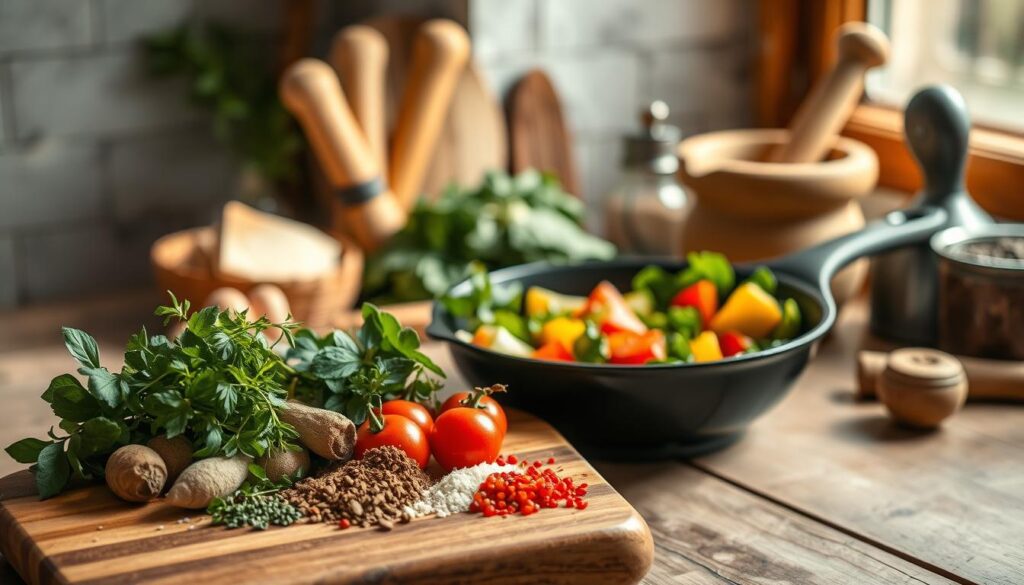
By mastering the use of herbs, spices, and simple sauces, you can significantly enhance your cooking and develop your style. Remember, the key to flavoring your dishes like a pro is experimentation and practice.
Cooking with Safety in Mind
Cooking safely is just as important as cooking deliciously, and beginners need to understand the basics of kitchen safety. A safe kitchen environment not only prevents accidents but also makes the cooking experience more enjoyable.
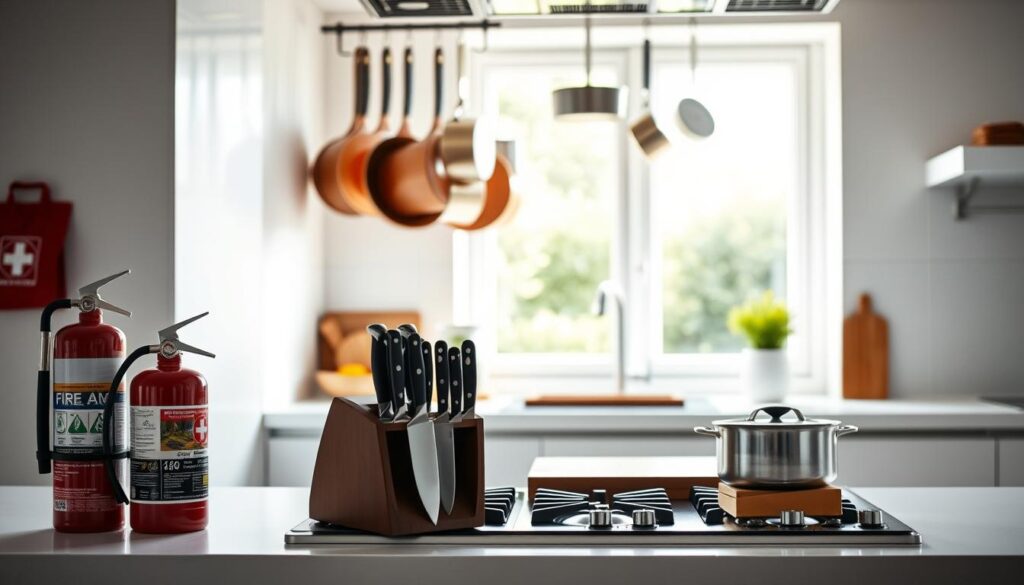
Kitchen Safety Tips for Beginners
To ensure a safe cooking environment, follow these beginner kitchen tips:
- Always keep a fire extinguisher in the kitchen and know how to use it.
- Use sharp knives and cutting boards correctly to prevent cuts.
- Be mindful of hot surfaces and keep a safe distance from children.
- Label and date leftovers and stored food to avoid confusion.
Additionally, maintaining a clean and organized kitchen is crucial. Regularly clean your countertops, sinks, and stove to prevent the buildup of bacteria and other pathogens. This practice is part of good cooking hacks for beginners, making meal preparation healthier and more efficient.
Food Storage Best Practices
Proper food storage is a critical aspect of beginner cooking essentials. Here are some tips to keep your food fresh and safe:
- Store food in airtight containers to maintain freshness and prevent contamination.
- Keep raw meat, poultry, and seafood separate from ready-to-eat foods to avoid cross-contamination.
- Use the “first in, first out” rule to ensure older items are consumed before they expire.
- Refrigerate perishable foods promptly and keep your refrigerator at a temperature of 40°F (4°C) or below.
By following these guidelines, beginners can significantly reduce the risk of foodborne illnesses and keep their kitchen safe and efficient. As you continue to cook and experiment with new recipes, these practices will become second nature, enhancing your overall cooking experience.
Finding Reliable Recipes
Reliable recipes are the backbone of successful cooking, especially for those just starting. With the vast amount of recipes available online and in cookbooks, it can be overwhelming to determine which ones to trust.
Where to Look for Beginner-Friendly Recipes
For beginners, it’s essential to find recipes that are not only delicious but also easy to follow. Reputable culinary websites such as Epicurious and Allrecipes offer a wide range of beginner-friendly recipes that are simple. These websites often include user reviews and ratings, which can help beginners gauge the success rate of a particular recipe.
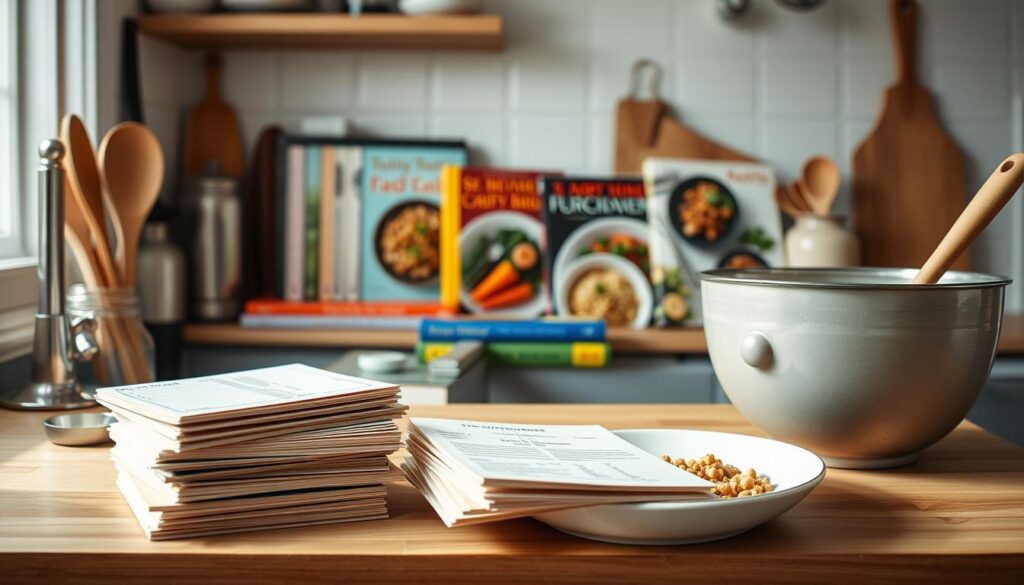
Another great resource for beginners is cookbooks specifically designed for novice cooks. These cookbooks typically include detailed explanations of cooking techniques and terminology, making it easier for beginners to understand and execute recipes.
Understanding Recipe Measurements
Understanding recipe measurements is crucial for achieving the desired outcome in cooking. Recipes often use various units of measurement, such as cups, tablespoons, and teaspoons. It’s essential to familiarize yourself with these measurements and understand how to convert between them. As Julia Child once said, “The only time to eat diet food is while you’re waiting for the steak to cook.” This quote emphasizes the importance of enjoying cooking and not being too strict with measurements.
“Measure ingredients with care, and you will be rewarded with dishes that are full of flavor and texture.”
To ensure accuracy, it’s also a good idea to invest in a digital kitchen scale, which can help you measure ingredients precisely. By following reliable recipes and understanding recipe measurements, beginners can set themselves up for success in the kitchen.
Embracing the Art of Experimentation
Embracing experimentation in cooking not only enhances your skills but also makes the cooking process more enjoyable. As you become more comfortable with basic cooking techniques, it’s time to start exploring new flavors and ingredients.
Experimenting with different ingredients and techniques allows you to develop your unique cooking style. It’s about understanding how different components work together to create a dish that’s not only delicious but also personalized to your taste.
Substituting Ingredients with Confidence
One of the key aspects of experimentation is substituting ingredients. This could be due to dietary restrictions, personal preferences, or simply because you’re missing an ingredient. To substitute with confidence, you need to understand the role of the ingredient in the recipe.
- Know the flavor profile: If a recipe calls for a specific herb or spice, understand its flavor profile and find a suitable substitute.
- Consider the texture: Ingredients like nuts or seeds add texture. If substituting, ensure the replacement offers a similar texture.
- Dietary adjustments: For vegetarian or vegan dishes, substituting animal products with plant-based alternatives is essential.
For more insights on cooking and experimenting with new recipes, visit our about page to learn more about our approach to cooking and recipe development.
When to Stick to the Recipe versus When to Improvise
Understanding when to follow a recipe to the letter and when to improvise is crucial. Baking, for instance, is a science where measurements and ingredients are critical. However, in cooking, there’s often more room for creativity.
| Situation | Stick to the Recipe | Improvise |
|---|---|---|
| Baking | Yes, measurements are crucial | No, unless you’re experienced |
| Cooking a new dish | Initially, yes, to understand the basics | After mastering the basics, yes |
| Using new ingredients | No, it’s a good opportunity to experiment | Yes, to discover new flavors |
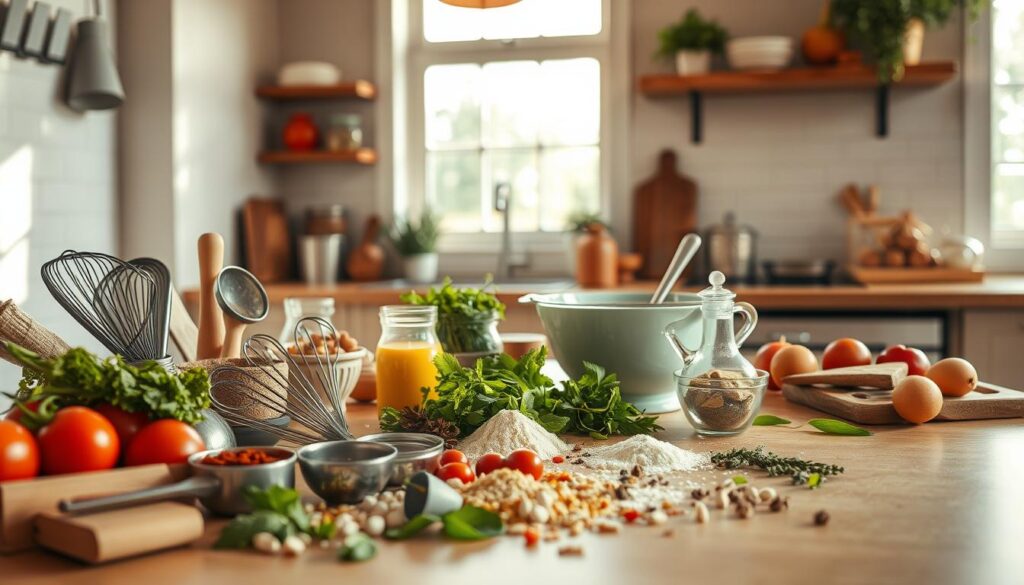
Experimentation is a journey, and it’s okay to make mistakes. The key is to learn from them and continue exploring. With time, you’ll develop a keen sense of what works and what doesn’t, making you a more confident and creative cook.
By embracing experimentation, you’re not just following recipes; you’re creating your own culinary identity. So, don’t be afraid to try new things and make mistakes – it’s all part of the cooking journey.
Building Confidence in the Kitchen
As you continue to explore the world of cooking, building confidence in the kitchen is essential. It’s normal to feel apprehensive about trying new recipes or techniques, but with practice and patience, you’ll become more comfortable and self-assured.
Practicing Resilience
Overcoming cooking fears and mistakes is a crucial part of the learning process. When things don’t turn out as expected, use these moments as opportunities to learn and improve. Analyze what went wrong and try again, incorporating beginner cooking tips and beginner kitchen tips to refine your skills.
Growing as a Home Cook
To continue growing as a home cook, stay curious and keep experimenting with new ingredients and techniques. Try out cooking hacks for beginners to simplify your cooking process and make meal preparation more enjoyable. With time and practice, you’ll develop your style and become more confident in your abilities.
FAQ
What are the essential kitchen tools every beginner should have?
Every beginner should have a good chef’s knife, cutting board, pots, pans, utensils like a spatula and tongs, and measuring cups and spoons. For more information on must-have utensils, check out reputable culinary websites like The Kitchn or Cook’s Illustrated.
How do I choose the right cookware for my kitchen?
When choosing cookware, consider the material, durability, and heat distribution. Stainless steel, cast iron, and non-stick pans are popular options. For tips on choosing the right cookware, visit websites like the Cookware Manufacturers Association or America’s Test Kitchen.
What are some simple cooking techniques for beginners to master?
Boiling, sautéing, and roasting are fundamental techniques that every beginner should know. For a detailed explanation of these techniques, check out our section on Mastering Basic Cooking Techniques. You can also find helpful resources on websites like Allrecipes or Epicurious.
How can I plan balanced meals on a budget?
To plan balanced meals on a budget, start by creating a weekly menu, shopping for fresh ingredients, and cooking in bulk. For more tips on meal planning, check out our section on Meal Planning 101. You can also find budget-friendly recipes on websites like Budget Bytes or The Plant Paradox.
What are some time-saving cooking hacks for busy schedules?
One-pot meals, prepping ingredients in advance, and using a slow cooker are great ways to save time in the kitchen. For more cooking hacks, check out our section on Time-Saving Cooking Hacks and visit our blog on www.cookflarerecipes.com for more recipe ideas.
How can I flavor my dishes like a pro?
Understanding herbs and spices, making simple sauces, and experimenting with different seasonings are key to flavoring your dishes like a pro. For more tips on flavoring your dishes, check out our section on Flavoring Your Dishes Like a Pro and visit websites like The Spruce Eats or Food Network.
What are some kitchen safety tips for beginners?
Always handle knives and hot pans with care, keep a fire extinguisher in the kitchen, and store food properly to avoid cross-contamination. For more kitchen safety tips, check out our section on Cooking with Safety in Mind and visit websites like USDA or FoodSafety.gov.
Where can I find beginner-friendly recipes?
You can find beginner-friendly recipes on websites like Allrecipes, Epicurious, or Food Network. You can also check out our section on Finding Reliable Recipes for more tips on where to look.
How do I substitute ingredients with confidence?
To substitute ingredients with confidence, understand the role of the ingredient in the recipe, choose a suitable substitute, and adjust the quantity as needed. For more tips on substituting ingredients, check out our section on Embracing the Art of Experimentation.
How can I build confidence in the kitchen?
To build confidence in the kitchen, start with simple recipes, practice regularly, and don’t be afraid to make mistakes. For more tips on building confidence, check out our section on Building Confidence in the Kitchen and visit websites like Cookpad or Kitchen Stories.

